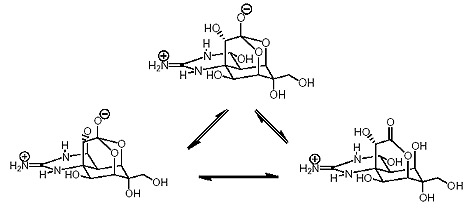|
- Chemical Properties -
New Scientist
January 20, 2001
" [Tetrodotoxin] is not an
alkaloid, steroid or carbohydrate and it is not
like any conventional amino acid. It's a low molecular weight, small
molecule
with a unique cage structure. "
-- as described by Harry Mosher
(Stanford University) who isolated the
toxin in the 1960s.
Name (IUPAC):
Octahydro-12-(hydroxymethyl)-2-imino-5, 9:7, 10a-dimethano-10aH-[1,3]
dioxocino[6,5-d]pyrimidine-4,7,10,11,12-pentol
CAS number: 4368-28-9
Molecular Formula: C11H17N3O8
Molecular Weight:
319.2706
|
Property
|
Calculated
Value1
|
Condition
|
|
Boiling Point
|
772.1 ¡Ó 70.0¢XC
|
Pressure: 760.0
Torr
|
|
Enthalpy of
Vapourisation
|
128.15 ¡Ó 6.0
kJ/mol
|
|
|
Vapour Pressure
|
1.58E-27 Torr
|
Temp: 25 ¢XC
|
|
Flash Point
|
420.7 ¡Ó 64.2 ¢XC
|
|
|
H acceptor
|
11
|
|
|
H donor
|
9
|
|
|
pKa
|
9.70 ¡Ó 0.70
|
most acidic
|
| pKa |
11.94 ¡Ó 0.70
|
most basic
|
|
1
Calculated using Advanced Chemistry Development (ACD) software Solaris
Version 4.67
|
-white crystalline solid
- water soluble non-protein
-Heat stable (except in allkaline
environment)
-darkens above 220¢XC without melting
- weak base pKa 8.7
-odourless
Tetrodotoxin exists in an equilibrium
mixture of its ortho ester, anhydride and lactone forms

"Equilibrium mixture"
-http://www.scripps.edu/chem/baran/images/grpmtgpdf/Vasan.pdf
|